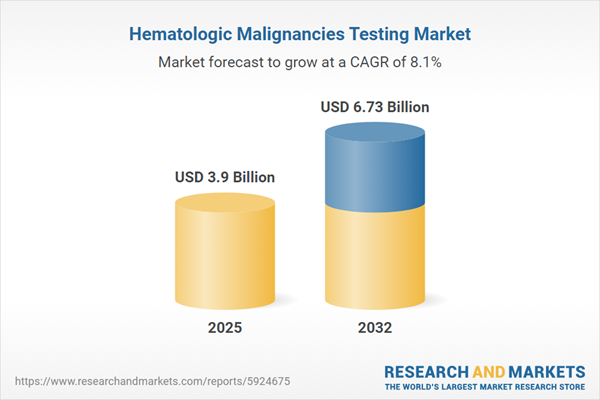Speak directly to the analyst to clarify any post sales queries you may have.
The hematologic malignancies testing market is rapidly advancing as innovative diagnostic technologies drive operational improvements and transform laboratory workflows. Senior decision-makers need clear insights to adapt successfully in this evolving landscape and lead with confidence amid regulatory and market shifts.
Market Snapshot: Hematologic Malignancies Testing Market Outlook
The hematologic malignancies testing market is forecast to grow from USD 3.60 billion in 2024 to USD 6.73 billion by 2032, representing a compound annual growth rate (CAGR) of 8.10%. This expansion is powered by the broad adoption of advanced molecular diagnostics, continual improvements in testing platforms, and greater emphasis on diagnostic accuracy. Laboratories prioritize high-resolution analytics and digital solutions to meet increased healthcare needs. Strategic alliances among diagnostic providers help ensure integration and efficient information sharing, supporting hematologic cancer diagnostics across varied care settings. Additionally, technologies such as data analytics, interoperable equipment, and cloud-enabled infrastructure are optimizing both quality and efficiency in laboratory operations.
Scope & Segmentation
- Technology: Cytogenetic approaches—including fluorescence in situ hybridization, karyotyping, and flow cytometry—are fundamental to detecting and classifying disease, enhancing both accuracy and speed in hematologic malignancy diagnostics.
- Immunohistochemistry: Next-generation instrumentation and customized protocols boost detection and enable timely, informed decisions in both liquid and tissue sample analysis.
- Molecular Diagnostics: Innovative tools such as next generation sequencing and polymerase chain reaction deliver granular genetic insights, empowering nuanced patient management and rapid clinical adjustment as conditions develop.
- Application: Versatile diagnostic platforms support the identification and profiling of conditions like leukemia, lymphoma, myelodysplastic syndromes, and multiple myeloma, providing value across a breadth of clinical environments.
- End User: Hospitals, academic medical centers, clinics, and reference laboratories deploy these testing solutions to elevate care standards and navigate the rising complexity of hematologic cases.
- Sample Type: Use of blood and bone marrow samples ensures laboratories remain agile, effectively addressing a variety of diagnostic scenarios.
- Test Mode: Centralized labs support scalable, high-throughput workflows, while decentralized formats and point-of-care technologies improve turnaround times and support access in geographically dispersed locations.
- Regional Coverage: The global marketplace includes the Americas, Europe, Middle East and Africa, and Asia-Pacific, each characterized by distinct regulatory requirements and technology integration obstacles.
- Key Companies: Market leaders such as F. Hoffmann-La Roche AG, Abbott Laboratories, Danaher Corporation, Thermo Fisher Scientific Inc., Becton, Dickinson and Company, Siemens Healthineers AG, QIAGEN N.V., Illumina, Inc., Bio-Rad Laboratories, Inc., and Myriad Genetics, Inc. focus on research, international reach, and technological collaboration to advance innovation and market presence.
Key Takeaways for Senior Decision-Makers
- Integrated diagnostic processes strengthen standardization and reinforce the accuracy of blood cancer detection across diverse healthcare infrastructures.
- Strategic collaborations with digital health and device manufacturers foster faster deployment of solutions to address shifting oncology requirements.
- Laboratory automation and digital pathology resources improve data integrity and provide leaders with enhanced agility for monitoring multiple operational sites.
- Adoption of liquid biopsy methods speeds up disease identification, improves patient experience, and supports more tailored treatment strategies.
- Standardized laboratory protocols, harmonized with established quality controls, build trust with stakeholders and make compliance more manageable during times of regulatory evolution.
- Investment in robust IT architectures and analytics readies laboratories for surging test volumes and the increasing complexity of advanced healthcare models.
Tariff Impact on Market Operations
Recent U.S. tariff adjustments have led to increased costs for hematologic testing reagents and instruments, posing challenges in procurement and operational planning. Industry participants are responding by bolstering local supplier relationships and reinforcing risk management practices. To ensure uninterrupted patient and partner access, organizations are expanding diagnostics portfolios and fortifying supply chain strategies in response to ongoing market transitions.
Methodology & Data Sources
The insights for this report are based on direct interviews with laboratory leaders and in-depth quantitative surveys. All findings are validated using peer-reviewed literature, regulatory guidance, technical dossiers, and official company statements to ensure they are reliable and actionable for executive-level decision-making.
Why This Report Matters for Strategic Leaders
- Provides strategic frameworks for integrating diagnostics, proactive risk management, and operational adaptability to meet the demands of a fast-changing market environment.
- Supplies benchmarks and practical resources to guide investment, resource optimization, and organizational performance management in the hematologic malignancies testing landscape.
- Supports leadership teams with the insights needed to navigate regulatory and technological advancements, sustaining resilience and competitive edge.
Conclusion
This report delivers essential market intelligence to guide leaders in strategic planning, adaptive operations, and targeted investment as the hematologic malignancies testing sector continues its transformation.
Additional Product Information:
- Purchase of this report includes 1 year online access with quarterly updates.
- This report can be updated on request. Please contact our Customer Experience team using the Ask a Question widget on our website.
Table of Contents
3. Executive Summary
4. Market Overview
7. Cumulative Impact of Artificial Intelligence 2025
Companies Mentioned
The companies profiled in this Hematologic Malignancies Testing market report include:- F. Hoffmann-La Roche AG
- Abbott Laboratories
- Danaher Corporation
- Thermo Fisher Scientific Inc.
- Becton, Dickinson and Company
- Siemens Healthineers AG
- QIAGEN N.V.
- Illumina, Inc.
- Bio-Rad Laboratories, Inc.
- Myriad Genetics, Inc.
Table Information
| Report Attribute | Details |
|---|---|
| No. of Pages | 184 |
| Published | November 2025 |
| Forecast Period | 2025 - 2032 |
| Estimated Market Value ( USD | $ 3.9 Billion |
| Forecasted Market Value ( USD | $ 6.73 Billion |
| Compound Annual Growth Rate | 8.1% |
| Regions Covered | Global |
| No. of Companies Mentioned | 11 |









